
Written by

Senior Data Journalist, Culture Amp
Updated March 6, 2024. This article has been updated with new people science data, research, and advice.
Giving feedback is a normal part of our personal lives. We're more than happy to let our family members know what we think of their behavior, or submit online reviews for the restaurants we go to and for the things we buy. At work, however, giving feedback might not come as naturally. We want to make sure that the feedback we share with coworkers is useful and that it bolsters – rather than hurts – our work relationships.
What constitutes effective feedback?
Feedback can take two forms: reinforcing and redirecting.
People are usually more comfortable giving feedback about the things they want others to continue and do more of (reinforcing feedback) than they are suggesting things someone should do less of or stop entirely (redirecting feedback). The good news is that all feedback can become easier with practice, especially if you share it effectively.
We define effective feedback as that which:
- Includes at least one specific example for context [Situation]
- Cites behaviors and/or skills of the recipient [Behavior]
- Explicitly references the impact (positive, negative, or both) of the recipient’s contributions [Impact]
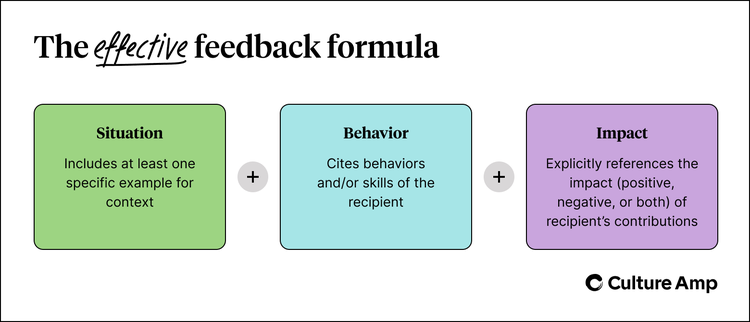
We’ll dive deeper into each of these components more.
Why does giving effective feedback matter?
Giving effective feedback strengthens the relationship between both parties, and is beneficial for both the person giving the feedback and the one receiving it.
The benefits for the giver are usually intuitive (e.g., the work becomes easier, future mistakes are avoided, etc.). But it also yields positive dividends for the receiver. But don’t just take our word for it – our research shows that receiving effective feedback improves an employee’s performance.
Looking at ratings between two consecutive performance reviews, we found that there were 5% more employees who improved in their performance ratings when they received five effective pieces of feedback compared to those who did not receive any feedback. Even more surprisingly, there were 2% fewer employees who improved in their performance ratings among those who received ineffective feedback compared to those who did not receive any feedback.
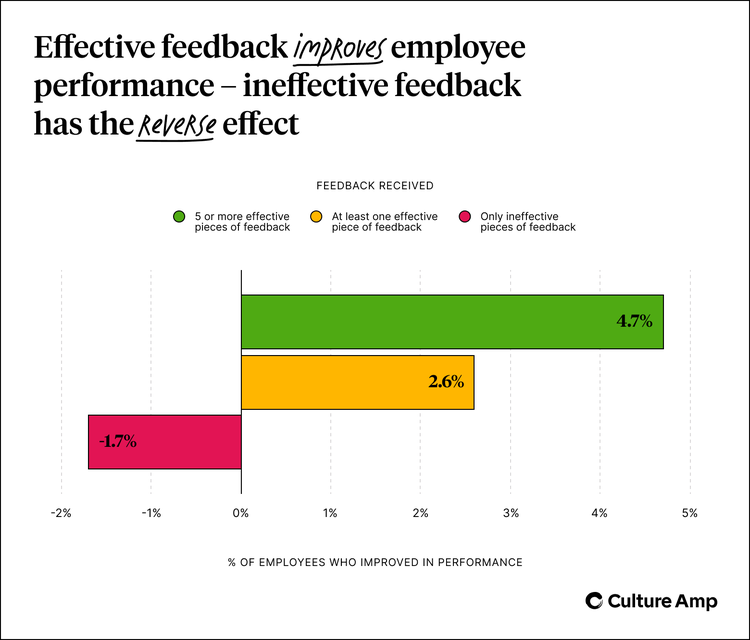
This finding reinforces that effective feedback (not just any old feedback) is what moves the needle on performance. In previous research, we also found that high performers, in particular, crave redirecting feedback to help them grow.
So, where do we begin? Here are six tips for giving effective feedback – both reinforcing and redirecting. The more you practice, the better you'll become.
6 tips for giving effective feedback
1. Be conscious of timing
Before giving feedback to someone, put yourself in their shoes. Are they in a good place to receive feedback? Are you in the right mindset to give it? Giving feedback when emotions are running high – i.e., directly after a heated meeting or disagreement – is not the best time. Strong emotions can cloud your ability to give feedback, especially if it’s redirecting.
Wait for a more neutral time to provide feedback. Often, setting aside a time where both parties can prepare emotionally and tactically leads to a more productive conversation. However, it’s important not to wait too long so that your feedback is still timely and relevant to the situation at hand.
The best time to give feedback, though, is when somebody is asking for it. In our research, we found that when feedback is requested, it is 16% more likely to be effective. So be sure to provide feedback when asked for it, as it indicates the person is already willing to hear your input.
2. Prepare, prepare, prepare
Before giving feedback, consider: What is the purpose of your feedback, and what do you want the outcome to be? Your feedback needs to include what the impact of their behavior is and how repeating or changing this behavior can make a positive difference for them and/or for others.
For example, telling someone that they need to “speak up more in meetings” without further context does not help that person understand why this behavior could be valuable. Think about why you’re asking someone to change their behavior. You could express that you want their ideas to be heard so the team does not miss any valuable opportunities. You could also share that this would help them gain more traction and influence within their team.
To prepare, it may help to write down the words you'll use and assess whether they will help the person move forward. Chloe Hamman, Director of People Science, Product at Culture Amp, says, “A quick mini-rehearsal in your head about the conversation can be beneficial.”
Preparing your intent for giving feedback is also crucial. Research shows that students who were told by their teachers that they had “very high expectations” but that they knew the students could reach them were more likely to revise their essays compared to those who weren’t. This framing was even more effective for the students who did not trust their teachers. Therefore, sharing your intent for feedback matters – especially if you are still building trust with the recipient.
3. Provide specific examples from personal experience
Whether providing reinforcing or redirecting feedback, it's important to be specific. Specific feedback ensures that someone can learn from it. It also serves as a basis for comparison and guides future behavior.
Telling someone they did a good job is a nice compliment, but it does not help them know what to repeat in the future. Specific feedback could look like: “I appreciated how you shared your idea about market segments in that meeting; it was something the team hadn't considered and made me realize we need to do more research.”
When sharing examples, make sure to reflect on your own experience with them, not on hearsay. For example, saying, “I've heard that you’re always late to meetings,” can make someone feel defensive. Their first instinct will likely be, “Who said this?” This line of thought ultimately detracts from the objective of the conversation, so instead, focus on what you have personally experienced to keep the dialogue between the two of you.
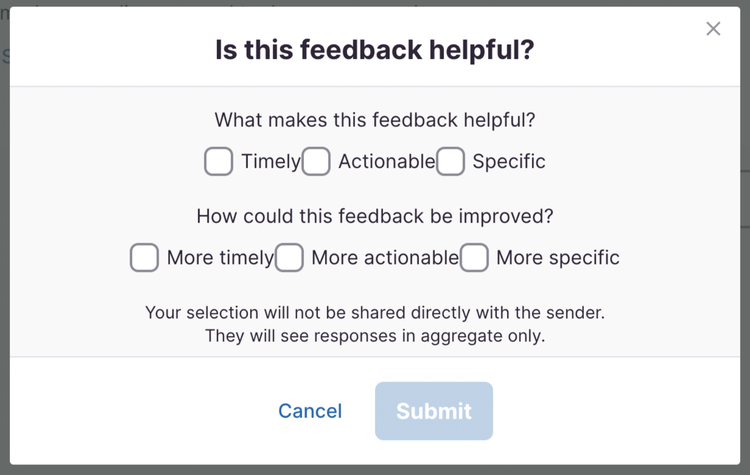
Interestingly, on the Culture Amp platform, employees were more likely to select our “specific,” “actionable,” and “timely” buttons in response to longer feedback. This is likely because folks who give longer feedback are sufficiently spelling out the relevant details of their feedback. So don’t be afraid of length if it helps you get specific.
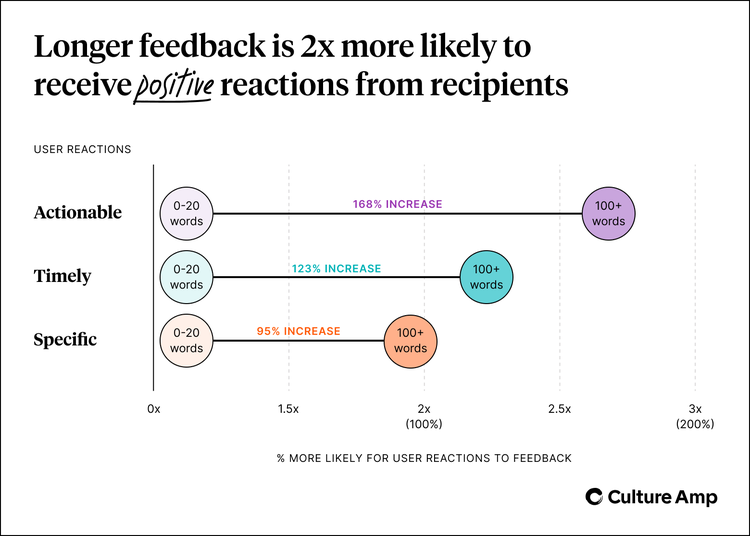
4. Make it actionable and future-oriented
It’s important to give feedback on specific behaviors or skills that someone can engage in or improve. Prioritizing behavior-based feedback (i.e., “In our last two team meetings, I noticed that you did not contribute to the discussion. Your perspective would have added value to the project“) over personality-based feedback (i.e., “You are too reserved in meetings”) is crucial to providing feedback that’s actionable.
Similarly, shifting away from reviewing past behavior to moving towards what that person can do (or change) in the future helps focus the conversation on improvement, not criticism. Brain scan research by Richard Boyatzis shows that when we are criticized for past behavior, it does not motivate us to change. Instead, we shut down and become defensive. In contrast, feedback that taps into what we can do to reach our goals results in a rush of dopamine, a mood-enhancing neurotransmitter, in the brain.
5. Make giving feedback a regular process
Not every action or scenario requires feedback, but it is important to make feedback a regular process. Continuous feedback allows employees to grow throughout the year, and creates an environment for improved communication, collaboration, and performance.
To incorporate continuous feedback in your organization, Fresia Jackson, Lead Researcher at Culture Amp shares: “As a manager, feedback can sometimes slip to the bottom of your to-do list. Blocking time at a regular cadence ensures that you’ll do it, like saving five minutes at the end of your 1:1s with reports. It’s also important to celebrate and debrief major milestones for your team members. Make sure to set up time after a significant meeting or at the end of the project to discuss the experience together.”
6. Don’t be afraid to share feedback with your manager or leader
Last but not least, when giving feedback, it’s important to examine to whom you are giving feedback. While it may feel daunting to share feedback with your manager or team leader, we found that giving upward feedback results in positive dividends for the organization.
Organizations that leverage upward feedback have more positive employee perceptions of their managers and leaders, and they have higher levels of motivation compared to companies that don’t.
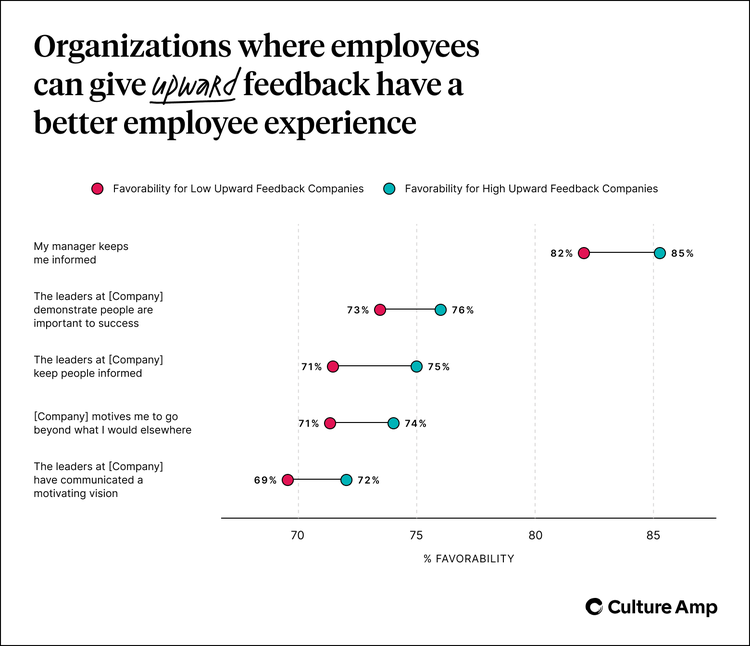
When offering feedback upward, make sure to still follow our previous advice (i.e., find the right time, prepare for the conversation, and make the feedback actionable, specific, and future-oriented).
Give feedback that people actually want to implement
Now that you have these six tips for giving effective feedback, we believe you’re ready to go out there and have better conversations with your colleagues, managers, leaders, and direct reports. Although giving effective feedback may feel uncomfortable when it’s redirecting, the long-term benefits far outweigh the temporary discomfort.
Invest in your colleagues’ growth and success by sharing with them what you appreciate about them and how they can improve how they’re showing up at work.
Finally, to build a culture of feedback in your organization, start role modeling by simply asking for it. This can have a ripple effect within your organization and show that all people can benefit from feedback.
You’ll all get better together.
More resources on giving feedback:
- The power of giving constructive feedback
- 3 strategies for giving better feedback
- How to give feedback across cultures
- How to give feedback to peers
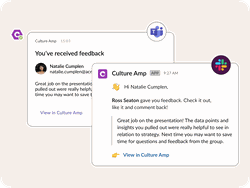
Build a culture of continuous feedback
Accelerate business growth via continuous developmental feedback


